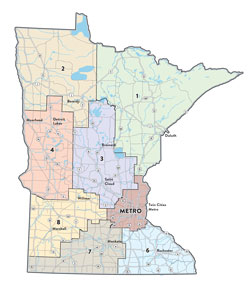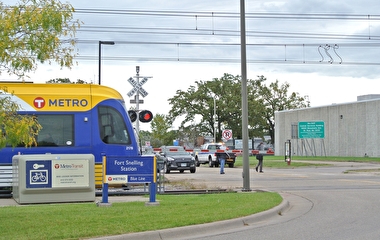Transportation funding comes from all levels of government—federal, state, and local. Funding that is directly generated by local taxes and fees stays in corresponding local jurisdictions (counties, cities, and townships, for example). Federal and state transportation funding, however, is allocated through certain budgetary procedures and may not be used in the original point of collection. How are these transportation funds redistributed in Minnesota? An analysis from U of M researchers offers new perspectives.
For the study, which looked at the six-year period between 2009 and 2014, the researchers analyzed funding revenues and expenditures at the district level (see map of Minnesota’s eight districts) for both roadways and transit.
“We chose this approach for several reasons,” says principal investigator Jerry Zhao, associate professor in the Humphrey School of Public Affairs. “Federal and state transportation grants to local governments are often distributed to transportation districts before they are used in different counties. In addition, our approach smooths out annual fluctuations associated with transportation grants to individual counties.”
Others on the research team included Adeel Lari, director of innovative financing in the Humphrey School’s State and Local Policy Program, and research assistant Shengnan Lou.
The analysis included three steps. First, the researchers calculated the share of transportation revenues contributed from different localities. Second, they examined the share of federal and state transportation expenditures across different localities. Third, they compared the expenditure share and the revenue share for each district to see what areas contribute more than they receive, or vice versa.
“When we include both roadways and public transit, our findings indicate that the Metro district contributes about 48 percent of federal and state transportation revenues and receives about 51 percent of federal and state transportation expenditures,” Zhao says. “However, the expenditure-to-revenue ratio changes when we separate roads and transit. Metro counties receive about 88 percent of transit funding but 36 percent of highway funding.”
Other districts show different patterns. “Among eight districts, we expect to see higher and lower ratios of revenues and expenditures,” Zhao says. “For example, District 2 and District 1 receive more than they contribute, mainly because they receive a higher share of road expenditures than they contribute to road revenues. This is probably due to much lower population density in these counties.”
District 3 receives less than it contributes. “This is probably because this district has high traffic volumes and thus a high contribution of fuel taxes, combined with a low level of transit expenditures,” he says.
“The mechanisms by which we fund and finance transportation systems are complex,” says Ken Buckeye, program manager in MnDOT’s Office of Financial Management. “To be informed, it is essential that we know from a jurisdictional standpoint who pays and who benefits, and to understand this over time. This research is an important way to enhance the discussion about resource collections and redistribution in transportation and to help improve decision making.”
The project was completed as part of the U’s Transportation Policy and Economic Competitiveness Program (TPEC). A paper summarizing the analysis is available on the TPEC website.





